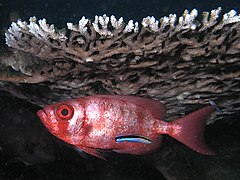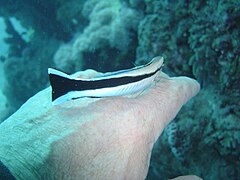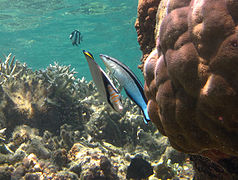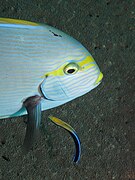Bluestreak cleaner wrasse (original) (raw)
From Wikipedia, the free encyclopedia
Species of fish
| Bluestreak cleaner wrasse | |
|---|---|
 |
|
| Conservation status | |
 Least Concern (IUCN 3.1)[1] Least Concern (IUCN 3.1)[1] |
|
| Scientific classification |
|
| Domain: | Eukaryota |
| Kingdom: | Animalia |
| Phylum: | Chordata |
| Class: | Actinopterygii |
| Order: | Labriformes |
| Family: | Labridae |
| Genus: | Labroides |
| Species: | L. dimidiatus |
| Binomial name | |
| Labroides dimidiatus(Valenciennes, 1839) | |
| Synonyms[2] | |
| Cossyphus dimidiatus Valenciennes, 1839_Labroides paradiseus_ Bleeker, 1851_Callyodon ikan_ Montrouzier, 1857_Labroides bicincta_ Saville-Kent, 1893_Labroides caeruleolineatus_ Fowler, 1945 |
The bluestreak cleaner wrasse (Labroides dimidiatus) is one of several species of cleaner wrasses found on coral reefs from Eastern Africa and the Red Sea to French Polynesia. Like other cleaner wrasses, it eats parasites and dead tissue off larger fishes' skin in a mutualistic relationship that provides food and protection for the wrasse, and considerable health benefits for the other fishes.[3][4][5] It is also notable for having potentially passed the mirror test, though this is not without controversy.[6][7][8][9]
This is a small wrasse, averaging 10 cm (3.9 in) long, at most 14 cm (5.5 in). It can be recognized thanks to a wide longitudinal black stripe running along the side and eye; the back and the stomach are white (sometimes slightly yellowish). This white part changes to a bright blue on the front of the animal, while the black band widens at the tail. The young are black with an electric blue line.
A genetic analysis of L. dimidiatus revealed the population fell into two monophyletic clades, with Indian Ocean populations generally having different stripe widths to western Pacific fishes. The Japanese cleaner wrasses, though, fell within the same group as Indian Ocean fish, despite differing in appearance, and both clades overlap around Papua New Guinea.[5] Two closely related cleaner wrasse species, Labroides pectoralis and Labroides bicolor, were grouped inside the L. dimidiatus clade, so the bluestreak cleaner wrasse may in fact be polyphyletic, incorporating several species.[5]
The bluestreak cleaner wrasse is found on coral reefs in the tropics from the Red Sea and Indian Ocean to the western Pacific (including Papua New Guinea, Japan, Fiji, and French Polynesia).[5] It was first recorded from the Kermadec Islands Marine Reserve north of New Zealand in 2015, after researchers examined hundreds of hours of unused documentary film footage.[10][11]
Drawing
Cleaner wrasses are usually found at cleaning stations. Cleaning stations are occupied by different units of cleaner wrasses, such as a group of youths, a pair of adults, or a group of females accompanied by a dominant male. When visitors come near the cleaning stations, the cleaner wrasses greet the visitors by performing a dance-like motion in which they move their rear up and down.[12] The visitors are referred to as "clients". Bluestreak cleaner wrasses clean to consume ectoparasites on client fish for food. The bigger fish recognise them as cleaner fish because they have a lateral stripe along the length of their bodies,[13] and by their movement patterns. Cleaner wrasses greet visitors in an effort to secure the food source and cleaning opportunity with the client. Upon recognising the cleaner and successfully soliciting its attention, the client fish adopts a species-specific pose to allow the cleaner access to its body surface, gills and sometimes mouth.[citation needed] Other fish that engage in such cleaning behavior include goby fish (Elacatinus spp.)[14] The bluestreak cleaner wrasse is known to clean balaenopteridae, chondrichthyans, homaridae, octopodidae, and dermochelyidae.
L. dimidiatus with a client surgeonfish at a cleaning station
Cleaner Wrasse with a client Moray eel
- Video of L. dimidiatus cleaning the gills of Acanthurus mata
"Fake" cleaner wrasse but true sabre-tooth blenny: Aspidontus taeniatus
Some fish mimic cleaner wrasses. For example, a species of blenny called Aspidontus taeniatus has evolved the same behavior to tear small pieces of flesh or skin from bigger fish rather than rid them of parasites. Another species, the bluestreak fangblenny, Plagiotremus rhinorhynchos, mimics juvenile cleaner wrasse so its presence is tolerated by the cleaners, which, it is assumed, enables it to take advantage of the concentration of potential victims.[15]
In different regions, the bluestreak cleaner wrasse displays various degrees of dependency on clients' ectoparasites as a primary food source. In tidal environments such as the Great Barrier Reef, the bluestreak cleaner wrasse is a facultative cleaner that feeds more on corals than on fish clientele.[16] Juvenile bluestreak cleaners are seen to bite their clients more often than the adults within that region, thus changing the dynamic of the known mutualistic relationship.[16] However, in regions where the bluestreak cleaners are solely dependent on clients' parasites, fish who have access to cleaning services have better body condition than those without cleaner access.[17] In the Marsa Bareika of the Ras Mohamed Nature Reserve, Egypt, the bluestreak cleaner wrasse live in specific sectors of the shallow reefs and are shown to rely on ectoparasites from species such as the brown surgeonfish and white belly damselfish.[17] In this region, fish that visit cleaner wrasses have lower antibody responses than those without cleaner access, suggesting that cleaner access may decrease the need for active immunity.[17]
Cleaner wrasse males defend specific living territories from other males in which they are able to have control over the females in those territories. When the dominant male no longer exists in that territory, one of the larger females is able to change sexes to take control over that territory. [18]
- ^ Shea, S.; Liu, M. (2010). "Labroides dimidiatus". IUCN Red List of Threatened Species. 2010: e.T187396A8523800. doi:10.2305/IUCN.UK.2010-4.RLTS.T187396A8523800.en. Retrieved 19 November 2021.
- ^ Eschmeyer, William N.; Fricke, Ron & van der Laan, Richard (eds.). Labroides "Species in the genus 'Labroides'". Catalog of Fishes. California Academy of Sciences. Retrieved 13 January 2020.
- ^ Côté, I.M. (2000). "Evolution and ecology of cleaning symbioses in the sea". Oceanography and Marine Biology: An Annual Review. 38 (1): 311–355.
- ^ Johnson, M.L. (2012). "High street cleaners". Biodiversity Science. Archived from the original on 2022-01-25. Retrieved 2012-02-04.
- ^ a b c d Sims, C.A.; Riginos, C.; Blomberg, S.P.; Huelsken, T.; Drew, J.; Grutter, A.S. (2013). "Cleaning up the biogeography of Labroides dimidiatus using phylogenetics and morphometrics". Coral Reefs. 33: 223–233. doi:10.1007/s00338-013-1093-2. S2CID 17804061.
- ^ Kobayashi, Taiga; Kohda, Masanori; Awata, Satoshi; Bshary, Redouan; Sogawa, Shumpei (2024-09-11). "Cleaner fish with mirror self-recognition capacity precisely realize their body size based on their mental image". Scientific Reports. 14 (1): 20202. doi:10.1038/s41598-024-70138-7. ISSN 2045-2322. PMC 11390716.
- ^ Kohda, Masanori; Bshary, Redouan; Kubo, Naoki; Awata, Satoshi; Sowersby, Will; Kawasaka, Kento; Kobayashi, Taiga; Sogawa, Shumpei (2023-02-14). "Cleaner fish recognize self in a mirror via self-face recognition like humans". Proceedings of the National Academy of Sciences. 120 (7): e2208420120. Bibcode:2023PNAS..12008420K. doi:10.1073/pnas.2208420120. ISSN 0027-8424. PMC 9963968. PMID 36745814.
- ^ Kohda, Masanori; Hotta, Takashi; Takeyama, Tomohiro; Awata, Satoshi; Tanaka, Hirokazu; Asai, Jun-ya; Jordan, Alex L. (2019-02-07). "If a fish can pass the mark test, what are the implications for consciousness and self-awareness testing in animals?". PLOS Biology. 17 (2): e3000021. doi:10.1371/journal.pbio.3000021. ISSN 1545-7885. PMC 6366756. PMID 30730878.
- ^ Devlin, Hannah (2019-02-07). "Scientists find some fish can 'recognise themselves' in mirror". The Guardian. ISSN 0261-3077. Retrieved 2024-09-11.
- ^ Liggins, Libby; Sweatman, Jenny Ann; Trnski, Thomas; Duffy, Clinton A. J.; Eddy, Tyler D.; Aguirre, J. David (2020). "Natural history footage provides new reef fish biodiversity information for a pristine but rarely visited archipelago". Scientific Reports. 10 (1): 3159. Bibcode:2020NatSR..10.3159L. doi:10.1038/s41598-020-60136-w. PMC 7035361. PMID 32081990.
- ^ Hancock, Farah (16 March 2020). "New species accidentally discovered on film". Newsroom. Retrieved 2020-03-16.
- ^ Froese, Rainer. "Labroides dimidiatus". FishBase. Retrieved 16 September 2013.
- ^ Stummer, L.E.; Weller, J.A.; Johnson, M.L. & Côté, I.M. (2005). "Size and stripes: how clients recognise cleaners". Animal Behaviour. 68 (1): 145–150. doi:10.1016/j.anbehav.2003.10.018. S2CID 53299983.
- ^ M.C. Soares; I.M. Côté; S.C. Cardoso & R.Bshary (August 2008). "The cleaning goby mutualism: a system without punishment, partner switching or tactile stimulation" (PDF). Journal of Zoology. 276 (3): 306–312. doi:10.1111/j.1469-7998.2008.00489.x.
- ^ Johnson, Magnus & Hull, Susan (2006). "Interactions between fangblennies (Plagiotremus rhinorhynchos) and their potential victims: fooling the model rather than the client?". Marine Biology. 148 (1): 889–897. Bibcode:2006MarBi.148..889J. doi:10.1007/s00227-005-0118-y. S2CID 85772684.
- ^ a b Dunkley, Katie; Ward, Ashley J. W.; Perkins, Sarah E.; Cable, Jo (March 2020). "To clean or not to clean: Cleaning mutualism breakdown in a tidal environment". Ecology and Evolution. 10 (6): 3043–3054. Bibcode:2020EcoEv..10.3043D. doi:10.1002/ece3.6120. ISSN 2045-7758. PMC 7083704. PMID 32211175. S2CID 214041635.
- ^ a b c Ros, Albert F.H.; Lusa, Jeanne; Meyer, Meghann; Soares, Marta; Oliveira, Rui F.; Brossard, Michel; Bshary, Redouan (January 2011). "Does access to the bluestreak cleaner wrasse Labroides dimidiatus affect indicators of stress and health in resident reef fishes in the Red Sea?". Hormones and Behavior. 59 (1): 151–158. doi:10.1016/j.yhbeh.2010.11.006. hdl:10400.12/1245. PMID 21087610. S2CID 18666960.
- ^ Kuwamura, Tetsuo; Tanaka, Naomi; Nakashima, Yasuhiro; Karino, Kenji; Sakai, Yoichi (May 2002). "Reversed Sex-Change in the Protogynous Reef Fish Labroides dimidiatus". Ethology. 108 (5): 443–450. Bibcode:2002Ethol.108..443K. doi:10.1046/j.1439-0310.2002.00791.x. ISSN 0179-1613.
- Meulengracht-Madsen, Jens: (1976) Akvariefisk i farger, J.W. Cappelens forlag AS
- Labroides dimidiatus at FishBase






